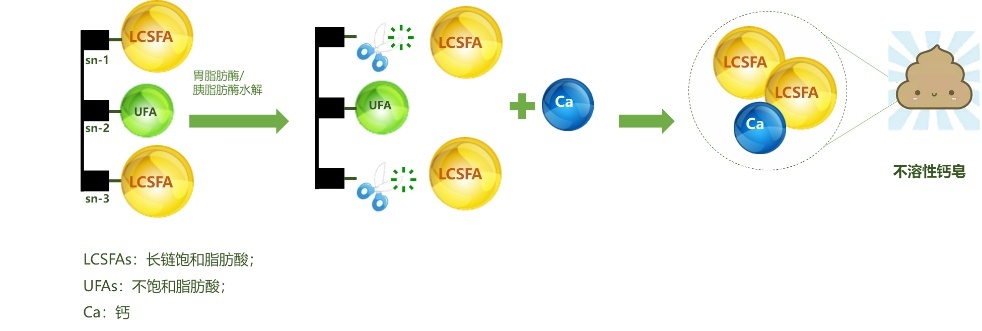白金有机脂是指配方粉中的优化脂肪组合,即通过降低sn-1,3位长链饱和脂肪酸的占比,提升婴幼儿对脂肪酸和钙的消化吸收力,
研究发现,母乳中长链饱和脂肪酸(LCSFAs)多位于sn-2位,更符合婴儿肠道生理特性;而一般配方粉中LCSFAs多位于sn-1/3位,不易吸收,且会在人体消化过程中与钙结合,形成钙皂排出体外,进而发生胃肠道不耐受、脂肪和钙吸收不良、硬便、便秘等问题1-5。
因为婴幼儿胃肠道发育不成熟,胆盐浓度低于成人,LCSFAs在婴儿的肠道中不易吸收,与钙结合形成不溶性的脂肪酸-钙皂,造成脂肪酸、钙丢失并引起硬便7。
研究表明,降低配方粉sn-1,3位长链饱和脂肪酸的比例(小于13%),形成的白金有机脂可以促进婴儿对脂肪酸和钙的吸收,减少硬便发生6。

配方粉中用于改善婴儿配方粉中脂肪及钙的生物利用度,生成白金有机脂,降低钙皂生成方法通常有两种6:
(1)使用结构脂OPO,增加sn-2位置棕榈酸的比例,从而降低sn-1、3棕榈酸的水平。
(2)开发含有棕榈酸总体水平低的婴儿配方粉,从而使sn-1、3长链饱和脂肪酸(LCSFAs)的占比不超过母乳中的水平。
2017年在《Leukotrienes and Essential Fatty Acids》发表的一篇综述,对14项在足月婴儿中开展的临床研究进行分析6。通过计算研究所采用的配方粉中sn-1,3位LCSFAs占总脂肪酸的比例,发现当该比例小于20%时,喂养的婴儿粪便中棕榈酸皂明显减少;当该比例小于13%时,喂养的婴儿粪便硬度明显降低、脂肪酸和钙吸收率增加,喂养效果进一步接近母乳水平。
参考文献:
1. J.S. Hyams, W.R. Treem, N.L. Etienne, H. Weinerman, D. MacGilpin, P. Hine, K. Choy, G. Burke, Effect of infant formula on stool characteristics of young infants, Pediatrics 95 (1995) 50–54.
2. B. Lloyd, R.J. Halter, M.J. Kuchan, G.E. Baggs, A.S. Ryan, M.L. Masor, Formula tolerance in postbreastfed and exclusively formula-fed infants, Pediatrics 103 (1999) E7.
3. P.T. Quinlan, S. Lockton, J. Irwin, A.L. Lucas, The relationship between stool hardness and stool composition in breast- and formula-fed infants, J. Pediatr. Gastroenterol. Nutr. 20 (1995) 81–90.
4. V.T. Tunc, A.D. Camurdan, M.N. Ilhan, F. Sahin, U. Beyazova, Factors associated with defecation patterns in 0-24-month-old children, Eur. J. Pediatr. 167 (2008) 1357–1362.
5. L.T. Weaver, G. Ewing, L.C. Taylor, The bowel habit of milk-fed infants, J. Pediatr. Gastroenterol. Nutr. 7 (1988) 568–571.
6. Petit V, et al. Importance of the regiospecific distribution of long-chain saturated fatty acids on gut comfort, fat and calcium absorption in infants[J]. Prostaglandins, Leukotrienes and Essential Fatty Acids, 2017, 121:40-51.
7. U. Bracco, Effect of triglyceride structure on fat absorption, Am. J. Clin. Nutr. 60(1994) 1002S–1009S.

